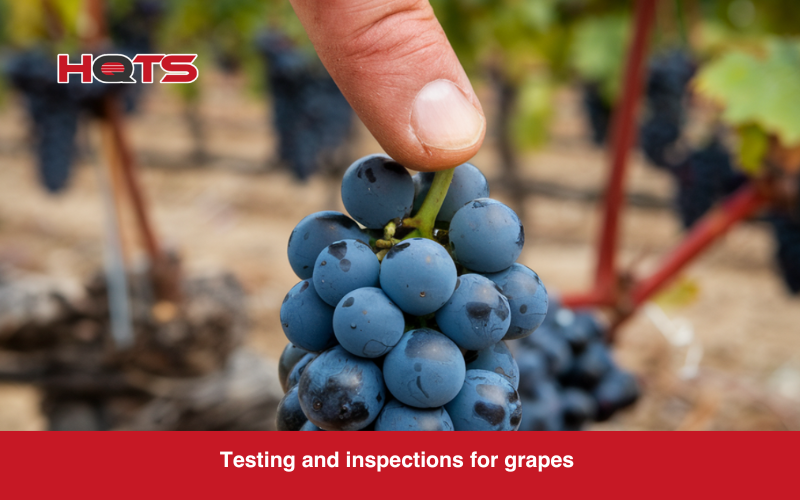The global agricultural market plays a crucial role in growing and processing a wide range of food products. In fact, many countries are leading producers of fruits and vegetables, supplying markets worldwide. Grapes, in particular, hold significant export potential. They thrive in hot, dry climates and come in various types—colored, white, seeded, and seedless—making them a versatile choice for consumers. Additionally, they grow well at elevations of up to 250 meters above sea level, allowing for diverse cultivation regions.
International trade in fruits and vegetables requires strict quality control to meet global market standards. Many countries enforce rigorous testing for pesticide residues and Maximum Residue Limits (MRLs) to ensure food safety. Regulatory bodies, such as the European Food Safety Authority (EFSA) and the U.S. Food and Drug Administration (FDA) or the indian The Agricultural and Processed Food Products Export Development Authority (APEDA), set guidelines that exporters must follow. Compliance with these standards, alongside certifications from organizations like GlobalG.A.P. and HACCP, ensures that agricultural products remain safe, high-quality, and competitive in global markets.
Testing and Inspection Services for Exporting Grapes Worldwide
To export grapes successfully, meeting the safety and quality standards of importing countries is non-negotiable. This involves several key inspections:
- Phytosanitary checks ensure the grapes are free from pests and diseases that could pose a risk to agriculture.
- Quality assessments focus on factors like sugar levels, acidity, size, and overall appearance.
- Safety tests verify that pesticide, herbicide, and contaminant levels stay within acceptable limits.
Since these requirements can vary widely between countries, comprehensive testing is an essential part of the export process.
MRL Testing for Grapes
To ensure grapes are safe for consumption, Maximum Residue Limit (MRL) testing is used to measure pesticide and chemical levels, keeping them within the safety standards set by regulatory authorities. Advanced techniques like gas chromatography and mass spectrometry are used to detect and quantify contaminants.
Key Testing Areas for Grapes
- Pesticide Residues: Verifies that pesticide levels comply with legal limits.
- Microbiological Contaminants: Screens for harmful bacteria, molds, and other microorganisms.
- Heavy Metals: Checks for contamination from soil or environmental factors.
- Physical Contaminants: Ensures the product is free from foreign materials.
- Quality Indicators: Measures sugar content (Brix), acidity, and ripeness to assess overall quality.
Regulatory Standards for Grapes
India (FSSAI Regulations):
- Maximum Residue Limits (MRLs): Pesticides and contaminants must comply with limits set under FSSAI regulations.
- Physical and Chemical Parameters: Standards for size, color, sugar content, and maturity.
- Packaging and Labeling: Adherence to requirements for origin, variety, nutritional information, and best-before dates.
European Union (EU Regulations):
- Marketing Standards: Grapes must meet quality categories such as Extra Class, Class I, and Class II.
- MRLs for Pesticides: Harmonized pesticide limits under Regulation (EC) No 396/2005.
- Food Additives and Contaminants: Compliance with strict usage limits for additives and contaminants.
United States (FDA Regulations):
- Pesticide Residue Limits: The U.S. Environmental Protection Agency (EPA) sets pesticide tolerance levels for grapes, which the FDA enforces through the Pesticide Monitoring Program (PMP). These limits are established under the Federal Food, Drug, and Cosmetic Act (FFDCA).
- Quality and Grading Standards: The USDA’s Agricultural Marketing Service (AMS) provides voluntary U.S. Grade Standards for table grapes, including factors such as size, color, and freedom from defects. Grapes are often classified as U.S. No. 1 or U.S. No. 2, with additional standards for specific varieties.
- Packaging and Labeling: Compliance with FDA labeling requirements under the Food Labeling Guide, including accurate declarations of product identity, net quantity, origin, nutritional facts, and allergen information if applicable. Additionally, grapes must meet the Food Safety Modernization Act (FSMA) requirements to ensure safe handling and traceability.
Ensuring the quality and safety of grapes for global export requires strict compliance with international standards. HQTS provides comprehensive inspection, testing, and certification services to help growers, exporters, and suppliers meet regulations set by FSSAI, the EU, FDA, and other global authorities. From pesticide residue analysis to packaging and labeling verification, our expertise ensures that your grapes meet the highest quality standards for smooth market entry.
Partner with HQTS for reliable quality assurance. Contact us today to ensure your grapes meet global compliance requirements!




